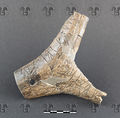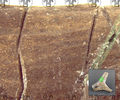SR-2
| Inscription | |
|---|---|
| Transliteration: | sφura·̣senθus / ]ẹ?eθinụ |
| Original script: | |
| Variant Reading: | ]ẹ?eθinạ |
|
| |
| Object: | SR-2 antler (antler) |
| Position: | front |
| Script: | North Italic script |
| Direction of writing: | sinistroverse |
| Letter height: | 1.21.2 cm <br /> – 3.9 cm |
| Number of letters: | 18 |
| Number of characters: | 19 |
| Number of lines: | 2 |
| Craftsmanship: | engraved |
| Current condition: | damaged |
| Date of inscription: | 3rd century BC [from object] |
| Date derived from: | archaeological context [from object] |
|
| |
| Language: | Raetic |
| Meaning: | 'son of ? for the community of Enθu*' (?) |
|
| |
| Alternative sigla: | IR 84 LIR SE-9 MLR 82 (a + b) TM 218460 |
| Sources: | Schumacher 2004: 156 |
Images
|
Object SR-2 antler with inscription SR-2.
|
Inscription SR-2 - detail.
|
Inscription SR-2 - detail (microscopic image).
|
Commentary
First published in Pellegrini & Sebesta 1965: 9 f. (no. 2). Autopsied by TIR in November 2014.
Images in Pellegrini & Sebesta 1965: 9 (drawing) and fig. 4 (photo), IR (drawing = LIR), LIR (photo), MLR (photo).
The piece of antler, being furcated, has an unusual shape for a Raetic "Hirschhornvotiv"; the two lines are inscribed starting from the two outer ends, running towards the broader end. Line 1 (length 8 cm) appears to be complete, as the edge before initial ![]() is fairly smooth, and a distinct space separates it from the letter. The end of the part bearing line 2 has broken off; length of the remains 4.5 cm. The size of the missing piece cannot be securely determined, but it may be assumed that all in all this part was not much longer than the other one. Less than a centimetre might be missing, possibly without letters on it. The question of which line should be read first is left open to interpretation.
is fairly smooth, and a distinct space separates it from the letter. The end of the part bearing line 2 has broken off; length of the remains 4.5 cm. The size of the missing piece cannot be securely determined, but it may be assumed that all in all this part was not much longer than the other one. Less than a centimetre might be missing, possibly without letters on it. The question of which line should be read first is left open to interpretation.
Despite some cracks and abrasions on the edge above the letters, the reading of line 1 is clear apart from the alleged punctuation mark. Pellegrini & Sebesta saw only a space between sφura and senθus; Mancini drew a short vertical scratch in the area, but did not alter the reading. Schumacher amended to sφura·senθus, declaring that a dot was clearly visible. Indeed, a vertical row of very faint short scratches can be made out; one of these in the upper area is slightly more pronounced than the others (see drawing). Despite the unusual form of the punctuation mark, the use of Venetic-style syllable punctuation in Montesei di Serso makes Schumacher's segmentation of the sequence into sφura·s and enθus more likely than an interpretation of the mark as a word separator and consequent segmentation into sφura and senθus. For the use of Venetic syllable punctuation in Raetic context see Script. sφuras is clear thanks to an Etruscan parallel; the remaining enθus might be interpreted as the name of the township Enθu*, also with the genitive ending -s.
In line 2, the first (preserved) letter is most probably ![]() – the edge above the first three letters is abraded, but the tip of the uppermost bar can be cearly seen. A reading
– the edge above the first three letters is abraded, but the tip of the uppermost bar can be cearly seen. A reading ![]() can be excluded: The hasta following
can be excluded: The hasta following ![]() is close to the bars, but followed by a space and trace of a bar / tip of an angle on the upper breaking edge, and must therefore belong to a separate letter before the next
is close to the bars, but followed by a space and trace of a bar / tip of an angle on the upper breaking edge, and must therefore belong to a separate letter before the next ![]() . Pellegrini & Sebesta and Mancini preferred
. Pellegrini & Sebesta and Mancini preferred ![]() before
before ![]() , but
, but ![]() (or indeed maybe
(or indeed maybe ![]() ) is more likely regarding the size of the space. The last letter is most probably
) is more likely regarding the size of the space. The last letter is most probably ![]() ; a reading as
; a reading as ![]() cannot be excluded because a fragment is missing right in the centre of the letter. A bar may have been situated in that spot; while
cannot be excluded because a fragment is missing right in the centre of the letter. A bar may have been situated in that spot; while ![]() in line 1 has a bar touching the left hasta in the bottom, the tallness of the last letters of line 2 might have caused a distortion of the letter shape. The sequence in line 2 can be interpreted as (the remains of) a patronymic in -nu. While a corresponding individual name would be expected, this part of the object could hardly have been long enough to bear one.
in line 1 has a bar touching the left hasta in the bottom, the tallness of the last letters of line 2 might have caused a distortion of the letter shape. The sequence in line 2 can be interpreted as (the remains of) a patronymic in -nu. While a corresponding individual name would be expected, this part of the object could hardly have been long enough to bear one.
Further references: Pellegrini & Sebesta 1965: 21 f., Tibiletti Bruno 1978: 235.
Bibliography
| IR | Alberto Mancini, "Iscrizioni retiche", Studi Etruschi 43 (1975), 249–306. |
|---|---|
| LIR | Alberto Mancini, Le Iscrizioni Retiche [= Quaderni del dipartimento di linguistica, Università degli studi di Firenze Studi 8–9], Padova: Unipress 2009–10. (2 volumes) |

